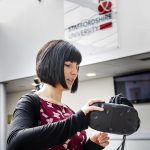[metaslider id=1650]
Between 2017-2019, researchers from Staffordshire University’s Centre of Archaeology have been awarded a prestigious research grant to develop new ways to record and present crimes scenes via virtual reality. The Dig For-Arch project was created in order to develop and apply novel digital recording methods and 5D, 4D and 3D modelling techniques for use by forensic archaeologists and crime scene investigators.
The examination of physical evidence and the environment in which it is found remains pivotal in the investigation of crime. There has also been a greater appreciation in recent years of the role of archaeologists in forensic contexts where buried or concealed evidence exists. However, recording techniques in forensic archaeological work, and in crime scene investigation in general, essentially remain focused on traditional means of documenting, sketching and photographing environments. These techniques can be laborious and they do not provide data outputs suitable for presentation in Court to non-experts.
However, a number of novel, digital non-invasive methods now exist which have the potential to increase search efficiency and accuracy, permit access to difficult and/or dangerous environments, create a more accurate record of buried or concealed evidence and provide more effective means of presenting evidence in Court.
Professor Caroline Sturdy Colls led the Dig For-Arch project, which developed and applied novel digital recording methods from archaeology and games technology to complex criminal investigations. Dante Abate, an experienced researcher with a background in digital archaeology, joined the Staffordshire University team to work on the project. The project, funded by a 182.000 Euro EU Marie Sklodowska-Curie grant, aimed to change the way in which buried and concealed evidence is analysed at crime scenes through these new techniques and through an associated programme of training and support for specialists and professionals working in this area.
Professor Caroline Sturdy Colls said:
“Traditional means of documenting, sketching and photographing crime scenes can be laborious and they do not provide data outputs suitable for presentation in Court to non-experts. A number of novel, digital non-invasive methods now exist which have the potential to increase search efficiency and accuracy, permit access to difficult and/or dangerous environments, create a more accurate record of buried or concealed evidence and provide more effective means of presenting evidence in Court”.
The project involved the testing of 3D laser scanning technologies and photogrammetry at mock scenes and several sites of conflict and genocide around the world.
Another technique that was trialled was the use of virtual reality (VR) motion capture headsets used in the gaming industry. This method can be used to allow the Police, barristers and jurors to “visit” scenes without actually travelling there. Experts from the Games Design department at Staffordshire University collaborated on the project, bringing their expertise in virtual reality to crime scene investigation.
Researchers worked collaboratively with industry leaders in laser scanning – Advanced Laser Imaging – and UK Police Forces. They worked with Staffordshire Police, who formed a Forensic Partnership with the Forensic and Crime Science department in 2016.
Simon Tweats, head of justice services at Staffordshire Police, said that the project will have major benefits for UK policing:
“Doing that [presenting evidence in court] in a way that is far easier for juries to understand and appreciate – which can only be be good for everybody, for prosecution and defense, in understanding precisely what has happened and what has gone on”.
Project Publications
Abate, D., Sturdy Colls, C., Moyssi, N., Karsili, D., Faka, M., Anilir, A. and Manol, S. (2019). Optimizing Search Strategies in Mass Grave Location Through the Combination of Digital Technologies. Forensic Science International: Synergy 1: 95-107. Open Access
Abate, D. and Sturdy Colls, C. (2018) A Multi-Level and Multi-Sensor Documentation Approach of the Treblinka Extermination and Labour Camps. Journal of Cultural Heritage 34: 129-135.
Abate, D., Toschi, I., Sturdy-Colls, C., and Remondino, F. (2018) PANORAMIC IMAGES, 2D FEATURE-BASED AND CHANGE DETECTION METHODS FOR THE DOCUMENTATION OF CONTAMINATED CRIME SCENES, Int. Arch. Photogramm. Remote Sens. Spatial Inf. Sci., XLII-2, 1-8.
Abate, D., Toschi, I, Sturdy Colls, C. and Remondino, F (2018) A LOW-COST PANORAMIC CAMERA FOR THE 3D DOCUMENTATION OF CONTAMINATED CRIME SCENES. International Society for Photogrammetry and Remote Sensing, XLII-2. pp. 1-8.

This project received funding from the European Union’s Horizon 2020 research and innovation programme under grant agreement No 708974”
In October 2016, the Digital Forensic Archaeology project was awarded the Innovative Digital Applications Award at the O2 NextGen Digital Challenge Awards, held at the House of Lords.

See BBC media coverage of the project

